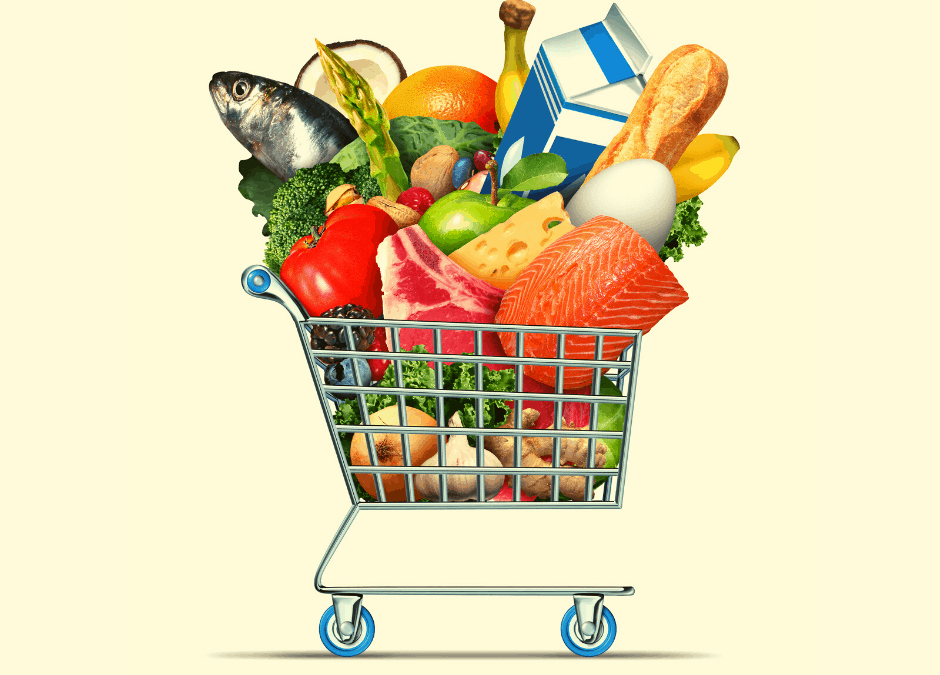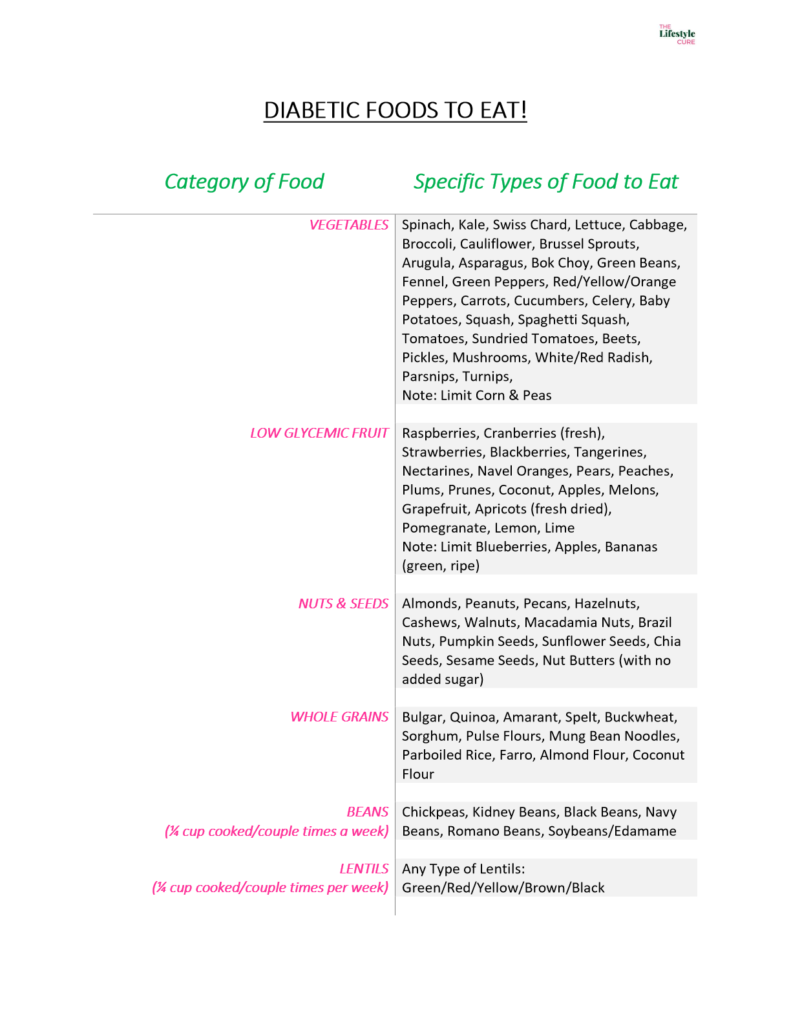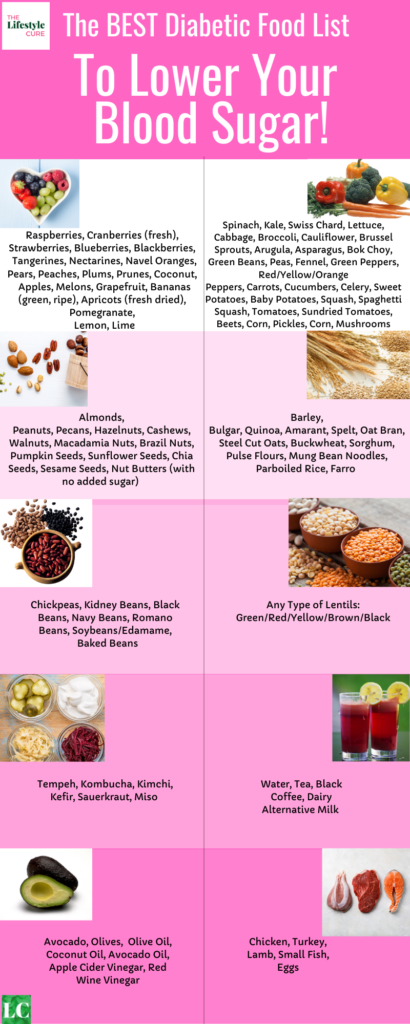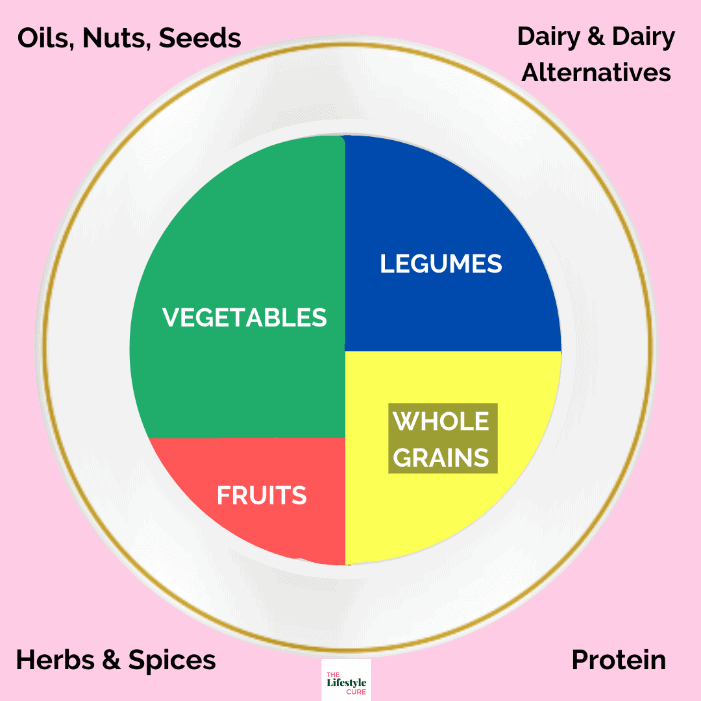As Doctors we write about evidence- based facts and with that in mind select products we believe to be the best for our readers. Thelifestylecure.com is a participant of the amazon associates program and we may earn a very small commission from qualifying purchases at no extra cost to you.
When it comes to diabetes, a healthy diet can not only lower your blood sugar but can also reverse your diagnosis all together. A diabetic food list can help those suffering from type 2 diabetes or prediabetes know exactly what foods to eat and what to avoid. Whether that’s at home, a restaurant or while grocery shopping this food list can be taken anywhere. But why is it so important? Let’s find out.
Table of Contents
What is Diabetes?
Diabetes Mellitus is a chronic, metabolic disease characterized by elevated levels of blood glucose (sugar). If not controlled, diabetes can lead to serious complications of the heart, blood vessels, nerves, eyes and kidneys.
Normally the pancreas releases insulin which helps glucose get into the cells to be used for energy. However, this function is impaired in those who have diabetes.
Types of Diabetes
Type 1 diabetes, also called insulin-dependent diabetes is caused by an autoimmune reaction. The immune system in this case attacks itself, specifically the pancreas, causing damage and destroying the cells that produce insulin.
Type 2 diabetes is more common and accounts for 90% of all diabetes cases. Here, the pancreas does not produce enough insulin or doesn’t use insulin well. This results in more glucose in the blood and less reaching the cells which can be harmful to many organs.
Although scary, type 2 diabetes can be reversed with lifestyle changes.
Gestational diabetes occurs when there is high blood sugar during pregnancy which can potentially affect the mother and the baby.
What is Prediabetes?
Prediabetes is a silent health condition which many Americans are unknowingly living with. Here, the blood sugar is higher than normal but not high enough to be considered type 2 diabetes.
Again, like type 2 diabetes, prediabetes can also be prevented and reversed with lifestyle changes such as a pre diabetic diet.
What is glycemic index?
The glycemic index (GI) is a scale that ranks carbohydrates-containing foods or drinks from 0 to 100 depending upon how much they raise blood glucose levels after it’s consumed. Low GI foods (≤ 55 GI units) are considered better for diabetics due to there slow and steady increase in blood glucose levels. High GI foods (≥ 70 GI units) increase blood glucose at a higher and faster rate and should be avoided as much as possible for those with prediabetes and type 2 diabetes.
Diabetes do’s and don’t’s
Diabetes do’s will always be whole foods. What does that mean? It means you should be eating foods like:
- Vegetables – are filled with fiber, protein and nutrients which helps to nourish the body, maintain blood sugar and keep you full. Non-starchy vegetables in particular are great for diabetics because they are low in carbohydrates keeping blood glucose under control.
- Fruits – even though fruits contain carbohydrates diabetics can still have them, they just need to be counted as a part of your meal plan. It’s best to choose fruits that are fresh, frozen or canned without added sugars.
- Unsalted Nuts and seeds – should be included in a diabetic diet because they contain magnesium and high levels of beneficial fats. These healthy fats help to both improve glycemic control and help diabetics reduce the risk of heart disease.
- Whole grains – are foods with good sources of fiber which can help slow the absorption of glucose in the blood.
- Beans – are packed with protein and fiber which have been shown to lower blood glucose levels in diabetics.
- Lentils – are complex carbs meaning they are high in fiber and digest slowly. They help not only control blood glucose levels but also appetite.
- Fermented foods- are rich in fiber which can stabilize blood glucose and help in weight loss. One study in particular showed these foods to reduce fasting blood glucose, postprandial blood glucose, glucose intolerance and insulin resistance.
- Eggs – have a low GI score, great for your waistline and are high in protein which is why it can be included in a diabetic diet. However, it’s important to eat in moderation as it can affect cholesterol which is something to be mindful of since diabetes is a risk factor for cardiovascular disease.
- Avocados- have many diabetes benefits including low in carbohydrates, high in fiber, may help with weight loss and improve insulin sensitivity.
- Organic, grass fed animal-protein – are loaded with complete protein, rich in vitamins and minerals, and contain healthy omega-3 fatty acids all things good for a diabetic diet.
- Herbs and Spices – are great to add to your dishes for flavor, satiety and a whole host of benefits. Particularly for diabetics, they bioactive compounds found in many culinary herbs and spices showed reduced blood glucose and fat.
Diabetes dont’s are foods that should be limited and they are:
- Processed/refined carbs – these foods are stripped of almost all fiber, vitamins and minerals and can be considered empty calories. These are high GI foods that cause rapid spikes in blood sugar levels.
- Processed meats – can increase cholesterol and weight which can be harmful for diabetics.
- High GI fruits – can increase blood glucose quickly making it difficult to control.
- Canned foods with added sodium or sugar.
- Pre-Packaged, frozen and fast foods – often contain hidden sugars, salt and preservatives which you should be wary of.
- Unhealthy fats – are trans fats that are bad for the waistline and heart especially for diabetics.
- Low-fat products – tend to replace fat with sugar.
- Salty – can raise blood pressure in diabetics putting them more at risk for heart disease
- Sweetened beverages – can create imbalances in a person’s insulin levels.
- Alcohol – should be had in moderation.
What Foods Can Diabetics Eat Freely- Diabetic Food List pdf
Diet is the cornerstone when it comes to managing blood sugars, which is why it’s important to know what foods diabetics can eat freely and which ones they cannot. By having a diabetic friendly food list on hand, you will not only understand what constitutes a diabetic diet but it will also help you stay on track.
The best way to use this this list is while grocery shopping or you can pin it to the fridge as a reminder when you go to eat. Additionally, this list of foods can also be used for those who are prediabetic.
Now that we know the basics here is:
Diabetic Food List (PDF) What To Eat
Download the complete Diabetic Food List (PDF) here
Diabetic Foods To Avoid pdf
We felt it was important to include a list of diabetic foods to avoid. Mainly because there are foods out there that tend to mask themselves as being really healthy when they actually aren’t. These are foods that have a high glycemic index and can elevate blood sugar levels and create insulin resistance over time. Please be aware of these foods when grocery shopping or when stocking your pantry.
Download the complete Diabetic Foods To Avoid List (PDF) here
Meal plate
Now that we have downloaded our diabetic diet food list (PDF) the next step is to figure out how much to eat in a single setting. It can become confusing if you are just learning how to eat as a diabetic which is why we encourage people to adopt the meal plate and fingertip method.
The plate method is a visual aid of portion sizes from the 4 main food groups presented on an actual plate. Side options outside of the plate are also shown.
It can be used as a daily reminder on how to create balanced, wholesome meals
We at The Lifestyle Cure have created our own plate method. We updated it so that it makes sense for today’s generation yet with the ability to be applied to anyone regardless of age or gender.
Since we know that there is no one-size-fits-all method when it comes to diet and lifestyle we wanted to provide two meal plates. Both meal plates have the capability to lower blood sugars, reverse diabetes and reduce waist size. It’s only a matter of preference and what is easy for you to incorporate into your daily lifestyle.
The first plate are for those who are interested in following more of the plant-based, Mediterranean diet while the second plate is for those keen on adopting a moderate carb, healthy fat diet.
The Lifestyle Cure’s Plate #1 Method:
- 4 main food groups – Vegetables, fruits, legumes, & whole grains
- 4 helpful & healthy additions to your plate – oils, nuts, and seeds, dairy and dairy alternatives, herbs and spices, & protein
Veggies and Fruits
½ Plate portion of vegetables and fruit, where the majority (approx. 75%) is made up of veggies and the rest is of fruit.
Legumes
On your plate ¼ portion should consist of legumes.
Whole Grains
On your plate ¼ plate portion should also consist of whole grains.
Oil, nuts, & seeds
Refer below to portion size measurements with hands for the amount that should be used.
Herbs & spices
You can use as much or as little of these that you want; there is no restriction as to how much you are allowed to use.
Dairy & dairy alternatives
There should not be an emphasis on dairy or its alternatives. And if you can, try and have more plant-based milk instead whenever the option is available.
Protein
Normally protein is considered to be one of the main food groups on a plate. However, we have moved protein to the side and replaced it with legumes. The reason behind that is that you can get a majority of protein from legumes as well.
The Lifestyle Cure’s Plate #2 Method:
- 4 main food groups – Vegetables, fruits, healthy fats, protein
- 4 helpful & healthy additions to your plate – water, dairy and dairy alternatives, herbs and spices, & supplements
Veggies and Fruits
½ Plate portion of vegetables and fruit, where the majority (approx. 75%) is made up of veggies and the rest is of fruit.
Healthy Fats
On your plate ¼ portion should consist healthy fats, oils, nuts, seeds, cheese, pasteurized eggs, fatty fish (salmon, mackerel, herring, sardines, anchovies) , grass-fed animals
Protein
On your plate ¼ plate portion should also consist of organic, grass-fed meat, pasteurized eggs, fermented foods, cheese, fatty fish and tuna, shellfish, legumes, greek yogurt, nuts and seeds.
Water
Have as much as you want before, during and after meals.
Herbs & spices
You can use as much or as little of these that you want; there is no restriction as to how much you are allowed to use.
Dairy & dairy alternatives
There should not be an emphasis on dairy or its alternatives. And if you can, try and have more plant-based milk instead whenever the option is available.
Supplements
There are many supplements that can be taken to help those with prediabetes, and type 2 diabetes. Some include but are not limited to psyllium husk, cinnamon, chromium, magnesium, thiamine etc.
However, before taking these supplements please talk to your doctor and see if they are right for you. Certain supplements can interact with your medication or be affected by other conditions you may have.
Measuring foods
Below is a helpful way to use your fingertips to your advantage when trying to eyeball the appropriate portions sizes for particular types of foods.
How to Measure Portion Size at your Fingertips:
- 1 cup of fruit or 1 medium size fruit = Fist
- 1 ounce of meat or cheese = Entire length of thumb
- 3 ounces of meat, poultry, or fish = Palm of hand
- 1-2 ounces of nuts or seeds = Cupped hand
- 1 tablespoon = Tip of thumb
- 1 teaspoon = Tip of finger
Planning your meals
Planning your meals is another great way to establish and maintain a diabetic diet.
Meal planning is the act of thinking ahead of time what you will eat for the next few days. Preparing meals before you get hungry has become very popular as of late because of the amazing benefits it has shown for health and wellbeing.
In fact, a 2017 study done in France observed that meal prepping amongst >40,000 participants was associated with a healthier diet and less obesity!
Whenever you have healthier food or snacks on hand, your chances of reaching for something processed and/or hitting up a fast food joint is decreased.
Meal plan sample
Below is a sample meal plan for diabetics to use as a guide when deciding what to eat. We’ve come up with 3 different options for breakfast, lunch, dinner and two snacks based on items found in the grocery list from above.
|
TIME OF DAY |
MEAL OPTION # 1 |
MEAL OPTION # 2 |
MEAL OPTION # 3 |
|
Breakfast |
Peanut butter & banana chia pudding | 2 Sunnyside eggs on top of avocado toasts | Mixed berries oatmeal with flax seeds and walnuts |
|
Snack # 1 |
Mixed nuts & seeds | A Banana | Green smoothie with kale/avocado/pineapple |
|
Lunch |
Vegetable soup with side salad & slice of avocado toast | Falafel wrap with side salad | Tofu poke bowl |
|
Snack # 2 |
An apple | An apple | An apple |
|
Dinner |
Turkey or veggie meatballs in tomato sauce with whole wheat/chickpea pasta | Black bean & sweet potato burgers with side of veggies & salad | Peanut chicken & veggies stir fry over a bed of brown rice/quinoa/bulgar/grain of choice |
Food as medicine, Impact of diet on diabetes
When we think of diabetes treatment we generally think of pills and insulin injections to improve glycemic control. But what more and more doctors are realizing is that food is proving to be a much more powerful drug when it comes to diabetes.
While a poor diet can lead to obesity and insulin resistance and thus creating an environment for type 2 diabetes to exist, embracing a healthy diet has been found to do the exact opposite.
Foods that are high in fiber and low in saturated fats and processed foods can improve blood glucose to the point of prevention and reversal of diabetes and prediabetes.
With that being said our hope is that by having access to this diabetic food list pdf you will feel more empowered when it comes to managing your chronic disease. Always remember that what you eat impacts your health, good and bad.
If you are interested in lowering your blood sugar and reversing your diabetes then be sure to check out our book SMART & Skinny Habits. We designed this program to help diabetics not only lose weight but REVERSE their diabetes permanently.
Click here to reverse your diabetes with SMART & Skinny Habits
If you enjoyed this article or have any questions please feel free to let us know and we will be happy to get back to you!
Stay happy. Stay healthy.








